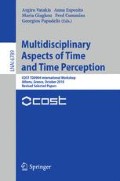Abstract
In the present study, we tried to improve the discrimination of short temporal intervals marked by two brief visual signals with an extensive and massive training involving the discrimination of intervals marked by brief auditory signals. Two groups completed two sessions of visual interval discrimination (pre- and post-test). Between the two sessions, participants were either discriminating intervals marked by auditory signals (experimental group) or waiting for a period equivalent to the auditory training (control group). Once a method (called jackknife) is applied to reduce the statistical noise inherent in individual psychometric functions, the results show that visual duration discrimination is improved in the post-test portion of the experiment, but this effect applies to both groups. Therefore, it is not possible to argue that the gain is due to the auditory training. The discrimination threshold in the visual condition remained much higher than the threshold observed in the auditory mode.
Access this chapter
Tax calculation will be finalised at checkout
Purchases are for personal use only
Preview
Unable to display preview. Download preview PDF.
References
Grondin, S.: Duration discrimination of empty and filled intervals marked by auditory and visual signals. Perception & Psychophysics 54, 383–394 (1993)
Grondin, S., McAuley, J.D.: Duration discrimination in crossmodal sequences. Perception 38, 1542–1559 (2009)
Grondin, S., Rousseau, R.: Judging the relative duration of multimodal short empty time intervals. Perception & Psychophysics 49, 245–256 (1991)
Ulrich, R., Nitschke, J., Rammsayer, T.: Crossmodal temporal discrimination: Assessing the predictions of a general pacemaker-counter model. Perception & Psychophysics 68, 1140–1152 (2006)
Grondin, S.: Sensory modalities and temporal processing. In: Helfrich, H. (ed.) Time and Mind 2002, pp. 75–92. Hogrefe & Huber, Goettingen, Ge (2003)
Lapid, E., Ulrich, R., Rammsayer, T.: Perceptual learning in auditory temporal discrimination: No evidence for a cross-modal transfer to the visual modality. Psychonomic Bulletin & Review 16, 382–389 (2009)
Rammsayer, T.: Effects of practice and signal energy on duration discrimination of brief auditory intervals. Perception & Psychophysics 55, 454–464 (1994)
Karmarkar, U.R., Buonomano, D.V.: Temporal specificity of perceptual learning in an auditory discrimination task. Learning and Memory 10, 141–147 (2003)
Wright, B.A., Buonomano, D.V., Manhcke, H.W., Merzenich, M.M.: Learning and generalization of auditory temporal-interval discrimination in humans. The Journal of Neuroscience 17, 3956–3963 (1997)
Westheimer, G.: Discrimination of short time intervals by human observers. Experimental Brain Research 129, 121–126 (1999)
Nagarajan, S.S., Blake, D.T., Wright, B.A., Byl, N., Merzenich, M.M.: Practice-related improvements in somatosensory interval discrimination are temporally specific but generalize across skin location, hemisphere, and modality. Journal of Neuroscience 18, 1559–1570 (1998)
Meegan, D.V., Aslin, R.N., Jacobs, R.A.: Motor timing learned without motor training. Nature Neuroscience 3, 860–862 (2000)
Grondin, S., Bisson, N., Gagnon, C., Gamache, P.-L., Matteau, A.-A.: Little to be expected from auditory training for improving visual temporal discrimination. NeuroQuantology 7, 95–102 (2009)
Grondin, S., Gamache, P.-L., Tobin, S., Bisson, N., Hawke, L.: Categorization of brief temporal intervals: An auditory processing context impair visual performances. Acoustical Science & Technology 29, 338–340 (2008)
Miller, J., Patterson, T., Ulrich, R.: Jackknife-based method for measuring LRP onset latency differences. Psychophysiology 35, 99–115 (1998)
Miller, J., Ulrich, R., Schwarz, W.: Why jackknifing yields good latency estimates. Psychophysiology 46(2), 300–312 (2009)
Smulders, F.T.Y.: Simplifying jackknifing of ERPs and getting more out of it: Retrieving estimates of participants’ latencies. Psychophysiology 47, 387–392 (2010)
Ulrich, R., Miller, J.: Using the jackknife-based scoring method for measuring LRP onset effects in factorial designs. Psychophysiology 38, 816–827 (2001)
Grondin, S.: Methods for studying psychological time. In: Grondin, S. (ed.) Psychology of time, pp. 51–74. Emerald Group Publishing, Bingley (2008)
Grondin, S.: From physical time to the first and second moments of psychological time. Psychological Bulletin 127, 22–44 (2001)
Grondin, S.: Timing and time perception: A review of recent behavioral and neuroscience findings and theoretical directions. Attention, Perception, & Psychophysics 72, 561–582 (2010)
Grondin, S.: Overloading temporal memory. Journal of Experimental Psychology: Human Perception and Performance 31, 869–879 (2005)
Author information
Authors and Affiliations
Editor information
Editors and Affiliations
Rights and permissions
Copyright information
© 2011 Springer-Verlag Berlin Heidelberg
About this chapter
Cite this chapter
Grondin, S., Ulrich, R. (2011). Duration Discrimination Performance: No Cross-Modal Transfer from Audition to Vision Even after Massive Perceptual Learning. In: Vatakis, A., Esposito, A., Giagkou, M., Cummins, F., Papadelis, G. (eds) Multidisciplinary Aspects of Time and Time Perception. Lecture Notes in Computer Science(), vol 6789. Springer, Berlin, Heidelberg. https://doi.org/10.1007/978-3-642-21478-3_8
Download citation
DOI: https://doi.org/10.1007/978-3-642-21478-3_8
Publisher Name: Springer, Berlin, Heidelberg
Print ISBN: 978-3-642-21477-6
Online ISBN: 978-3-642-21478-3
eBook Packages: Computer ScienceComputer Science (R0)

